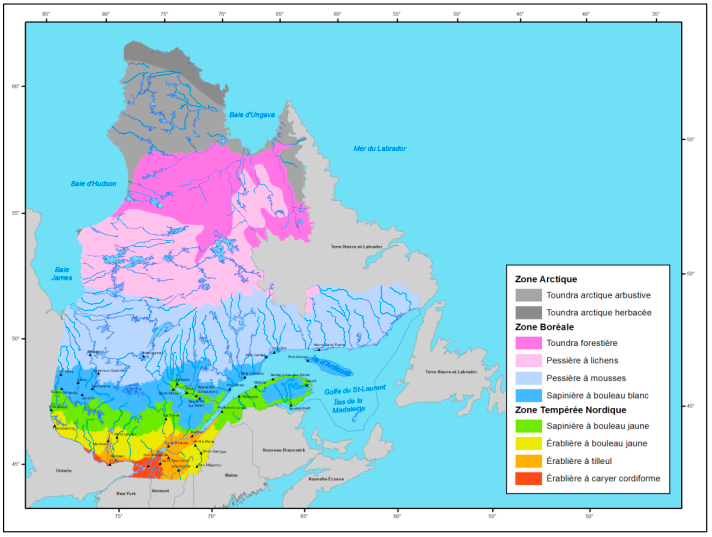Forests
Shifts and Contractions of Forest Habitat
Rising temperatures cause ecological niches to shift northward. On average, ecological niches in Quebec move at a rate of 45 km per decade. Certain species of plants will be unable to migrate north quickly enough and will not enjoy conditions that are favourable for their survival. Consequently, by the end of the century, between 5 and 20% of forest ecosystems may no longer be suitable for certain tree species.
Vegetation Zones and Bioclimatic Domains of Quebec

Delisle, J-F. (2019). Ressources et industries forestières du Québec, Portrait statistique 2018. Ministère des forêts, de la faune et des parcs (MFFP), Gouvernement du Québec, Québec.
The health and productivity of these forested areas could also diminish, which would have repercussions on the forestry industry. On the other hand, certain species (notably deciduous) could benefit from milder temperatures. As a result, they may expand their range, which would imply more land available for logging. However, this increased timbering potential could be limited by the northern boundary for logging determined by the Government of Quebec, unless this line is amended in the future.
Insect Epidemics and Disease
The forests of Quebec are already grappling with numerous insect pests such as the eastern spruce budworm and the forest tent caterpillar moth. Higher temperatures enable these species to expand their ranges northward. For example, eastern spruce budworm epidemics may subside in southern parts of the province but affect species such as the black spruce farther north.
Additionally, for certain pests, a warming climate can alter the relationships between the insects and their hosts and thereby increase the number of generations. Lastly, insect species or diseases that are not currently found in Quebec due to the province’s cold climate might also begin to appear.
Eastern spruce budworm (source: RNcan)
Definition | Number of generations
The number of generations refers to the number of times that a given species breeds per year. For example, the eastern spruce budworm and the forest tent caterpillar moth normally produce a single generation per year.
Forest Fires
It is anticipated that forest fires in Quebec will become more frequent and more intense due to rising temperatures and increased evapotranspiration, the result of which will be more frequent and more severe droughts. Additionally, the fire season will become increasingly prolonged, beginning earlier in spring and ending later in the fall. Moreover, the arrival of insects and diseases in new regions could potentially increase the flammability of the woodlands in these areas.
More frequent and more devastating fires degrade biodiversity and the ecosystem services that forests provide. Further, timber procurement becomes more difficult, which has significant economic ramifications. Lastly, rural populations exposed to forest fires suffer from physical and mental health problems, and the costs of evacuation and damage to infrastructure can become substantial.
Changes in Tree Growth
Rising temperatures and a longer growing season can have positive impacts on tree growth, especially at northern latitudes where growth is currently limited by low temperatures. However, this warming could exceed the tolerance threshold of certain species, which could limit any growth benefits. Additionally, the changes mentioned above (aggravation of drought-like conditions, fires and epidemics) are also limiting factors for tree growth.
Influence of Climate Change on Forestry Sector
Quebec’s forestry industry is a very important one, providing roughly 60,000 jobs across the province. With hundreds of municipalities depending on the sector for their vitality, the impacts of climate change must be taken into account.
Timber volumes could be set to decline due to the deterioration of productivity in forest ecosystems. By the end of the 21st century, some of the most important species – representing up to 72% of the total volume of merchantable trees – may no longer be compatible with their current range. The quality of timber harvested may also wane as a result of epidemics, droughts or fires.
Additionally, due to shorter, milder winters, access to forestry roads that are normally frozen will become increasingly challenging, which will have adverse effects on logging activities. In this regard, the forestry industry will experience climate change impacts in different ways and will be forced to adapt at a number of levels.
Quebec is well known for being a major producer of maple syrup. This sector is dependent on climate conditions (especially in spring) and therefore sensitive to climate change. More precisely, sugaring season will start earlier and earlier, in some cases by up to 2-3 weeks. Quebec’s more southerly regions may suffer a decline in their production due to shorter and shorter seasons. Commercial maple stands located farther north may stand to benefit as ideal temperatures for sugaring shift northward. Southern Quebec and the United States will be affected most.
Maple syrup production and climate change: Identifying maple syrup producers’ concerns and providing them with the best information to promote and support adaptation
Among many economic activities, the production of Maple syrup is one of the most directly related to the climate and particularly to the spring climate.